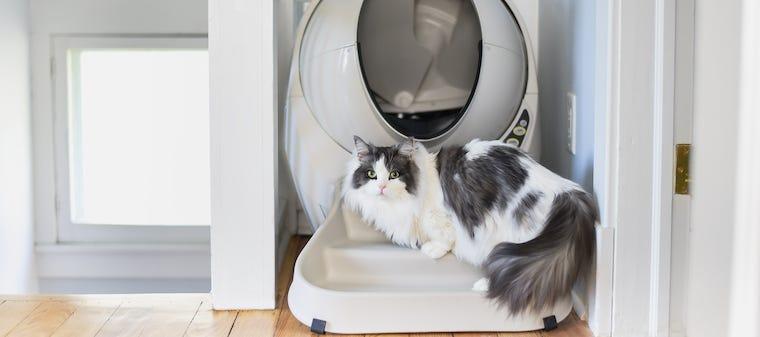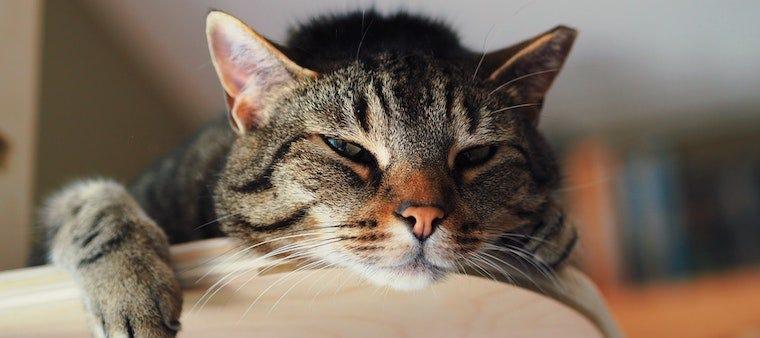Does your cat seem slower to jump onto the counter? If so, your cat may have arthritis. In this post we’ll discuss why arthritis in cats is often undertreated.
Arthritis is inflammation and secondary degeneration of one or more joints. It’s often called degenerative joint disease (DJD) or osteoarthritis (OA). Chronically, it can be debilitating and painful. It can be caused by previous trauma/injury, infections, congenital bone abnormalities, inappropriate diet (with abnormal calcium/phosphorus ratios), and obesity.
Most pet parents have no idea how prevalent arthritis in cats is. They assume that cats don’t get arthritis, as they amble and jump from their cat tree to the sofa with ease. However, in one veterinary study that evaluated X-rays of cats over 6 years of age, the prevalence of osteoarthritis was high: 61% of cats had evidence of osteoarthritis in at least one joint (specifically their shoulders, elbows, hips, or ankle joints), and almost 50% of cats had osteoarthritis in more than one joint.(1) Another study found that the average age that cats are diagnosed with osteoarthritis is slightly older—at 12 years of age—but almost 50% of these cats also had concurrent disease going on.(2) This goes to show us that arthritis is likely underrecognized, underdiagnosed, and undertreated by both pet owners and veterinarians in our feline family members.
As cats are such stoic creatures, they often don’t show signs of illness until it is very severe. So, how do you know if your cat has arthritis?
Signs of arthritis in cats
Signs of arthritis in cats include:
- changes in mobility
- altered gait
- being slower to jump
- slower to go up or down stairs
- being more hesitant to move or get up
- acting stiff when getting up
- limping
- stiff joints
- acting painful or reluctant to be touched
- defecating outside of the litter box
- atypical aggression
- decreased activity
When it comes to osteoarthritis, you’re probably aware of how common it is in dogs. You’ll find joint supplements, glucosamine, “doggy aspirin,” and even ads for veterinary prescription medications on TV for this. But, the options for treatment of arthritis in cats aren’t as great as they are in dogs, and I’ll discuss the pros and cons of some of them.
Treating arthritis in cats
So, how do we treat arthritis in cats?
Fight the fat: Dietary modification
Long-term studies done by Purina have shown that skinnier dogs live longer—on average by 1.4 years—and have less osteoarthritis. While these studies haven’t been done in cats, we veterinarians know that keeping your cat trim helps minimize the risk of medical problems like diabetes mellitus, arthritis, pancreatitis, cardiac problems, and more.
That’s why it’s important that you work with your veterinarian when it comes to getting your cat to be an ideal body weight. Most cats should be 9-10 pounds. If your cat is 12-14 pounds, it doesn’t sound like that much—only 2-4 pounds—but that could mean he is over 10-20% of his ideal body weight and is actually overweight or obese. Check out a great chart on ideal body weights for cats here.
You’ll also want to make sure that your cat is on both an appropriate diet and an appropriate amount of food. The biggest mistake I see people making is feeding their cat for their cat’s current weight—not the ideal body weight.
Another tip? Consider breaking up the amount of food into several smaller meals by using cat food puzzles. Not only will this slow your cat down while eating, but it’ll also provide some environmental enrichment.
Exercise
Another way to help keep the weight off and fight arthritis is to exercise your cat. Since those extra pounds add more stress and strain on your cat’s musculoskeletal system, exercise is a great preventive way of keeping your cat healthy. I’ll admit it, though: It’s hard to exercise a cat. When it comes to your cat’s health, it’s worth committing to a 5-minute laser pointer or feather-on-a-string play session a day. Schedule the play time as a reminder on your phone. Set the timer for 5 minutes, and voilà… not only will it help keep the pounds off, but it’ll provide even more environmental enrichment.
Nutritional supplements
There’s a lot of debate about how well certain nutritional supplements work. The good thing? They are generally very safe… if you can get your cat to eat them. My favorite? Cosequin. I sprinkle it onto a small amount of canned food (as a treat!) once a day to help reduce damage to the cartilage. Unfortunately, nutritional supplements generally need to be started earlier in life to have the most benefit. Keep in mind that if your cat is already geriatric (older than 15 years of age) and has severe arthritis, I have not found supplements to be helpful with late- or end-stage arthritis.
Environmental modification
If your cat is defecating outside of the litter box, this can be a classic sign of arthritis. That’s because your cat may have a harder time stepping into the raised walls of the litter box. By getting a larger litter box with lower sides (so it’s easier to get into the litter box) or using a Litter-Robot ramp, you can help provide some ease for your cat. When my 18-year-old cat started defecating outside of the box, I knew I needed to take action. I took X-rays on him and was shocked to see very severe osteoarthritis all down his back. After changing him to a Litter-Robot ramp and adding him onto pain medications, his accidents stopped!
Medical therapy
When it comes to treating arthritis in cats, know that there are several medication options. That said, you have to be able to medicate your cat. If you can’t give your cat a pill or liquid once or twice a day, you’ll have to figure out an alternative. When in doubt, talk to your veterinarian about getting the medications specially compounded by a veterinary compounding pharmacy into a concentrated, flavored medication (such as chicken- or tuna-flavored, miniature tablet sizes, etc.).
Gabapentin
Gabapentin is a very safe, inexpensive medication commonly used for cats with arthritis. The dose range is very wide (typically 25-50 mg orally every 8-24 hours as needed). While this drug has been used for seizure treatment in dogs and cats, I use it for treatment of “neuropathic” (nerve) pain. I used this in my own cat for arthritis and found it to work very well, although it can initially cause walking drunk and sedation(3) (which improves over time). It can be compounded or dosed carefully by capsule (it comes in 100 mg capsules). It also comes in a liquid, but most cats don’t like the flavoring. Some types may contain xylitol, but xylitol is only poisonous to dogs (not cats). This can be safely used long-term in cats.
Tramadol
Tramadol is also a safe, inexpensive medication used for pain. It has weak opioid-like properties and is metabolized/effective in cats.(4) However, the pill is very bitter, and even when compounded it can be hard to get into cats. That said, it is safe for long-term use.
NSAIDs
NSAIDs are non-steroidal anti-inflammatory prescription medications. While veterinary studies have shown that certain types can be safe for long-term use in cats,(5,6) I typically only use these at very low doses for pulse therapy (e.g., a few days in a row), as rarely, I can see acute kidney injury from it. When in doubt, contact your veterinarian about the use of NSAIDs in your cat and always make sure to follow up with blood work on your cat while using this. Please note, you should never use human medications on your pets without consulting your veterinarian, as both human and canine NSAIDS can cause kidney failure and stomach ulcers in cats at minute doses.
Steroids
Steroids like prednisolone can sometimes be used; however, in my opinion, these have a lot of side effects long-term. While steroids have anti-inflammatory properties, they can predispose a cat towards diabetes, and, rarely, other complications. These drugs are not my “go to” for treating arthritis, as I feel there are other drugs listed above that are safer to use long-term.
Physical rehabilitation
Some veterinary clinics offer rehab, and if your cat is pretty mellow, this may be a safe option to consider! I’ve even seen some cats use the treadmill swimming pool with grace. When in doubt, it’s worth making an initial appointment with a rehabilitation expert.
Acupuncture
I’ve personally had some great success with acupuncture for musculoskeletal/orthopedic injuries. If you have a board-certified veterinary acupuncturist in your area, this is also worth considering for the treatment of arthritis in cats!
When in doubt, talk to your veterinarian about whether your cat is “slowing down” or showing signs of arthritis. As cats are so stoic, we want to make sure our feline family members aren’t in hidden, masked pain. Make sure your cat has an appropriate work-up to diagnose arthritis—X-rays, blood work, and a urine test (to make sure they can be safely put on some of these medications). Help your cat live longer and be more comfortable!
References:
- Slingerland LI, Hazewinkel HAW, Meij BP, et al. Cross-sectional study of the prevalence and clinical features of osteoarthritis in 100 cats. Vet J 2011;187(3):304-9.
- Klinck MP, Frank D, Guillot M, Troncy E. Owner-perceived signs and veterinary diagnosis in 50 cases of feline osteoarthritis. Can Vet J 2012;53(11):1181-6.
- Guedes AG, Meadows JM, Pypendop BH, et al. Assessment of the effects of gabapentin on activity levels and owner-perceived mobility impairment and quality of life in osteoarthritic geriatric cats. J Am Vet Med Assoc 2018;253(5):579-583.
- Guedes AG, Meadows JM, Pypendop BH, et al. Evaluation of tramadol for treatment of osteoarthritis in geriatric cats. J Am Vet Med Assoc. March 2018;252(5):565-571.
- King JN, King S, Budsberg SC, et al. Clinical safety of robenacoxib in feline osteoarthritis: results of a randomized, blinded, placebo-controlled clinical trial. J Feline Med Surg 2016;18(8):632-42.
- Sul RM, Chase D, Parkin T, Bennett D. Comparison of meloxicam and a glucosamine-chondroitin supplement in management of feline osteoarthritis. A double-blind randomised, placebo-controlled, prospective trial. Vet Comp Orthop Traumatol 2014;27(1):20-6.









